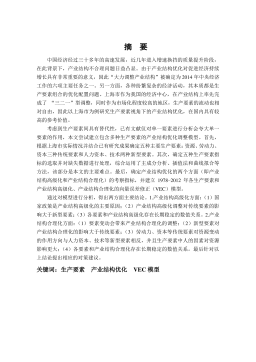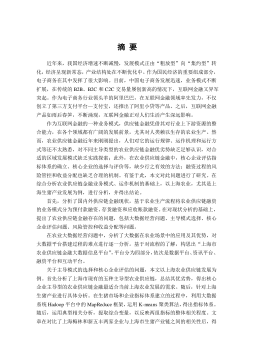5G公司证券营业部市场拓展策略研究
摘要证券业市场竞争日益激烈,新业务频现,中小型券商的万二“佣金宝”等竞争策略陆续上演,迫使证券业加速转型,不能再以传统的方式经营,需要由单一的经济业务模式转变为多元化的发展模式。G公司A证券营业部作为90年代早期成立的营业部,如何守住存量客户,把握市场机遇,开拓更多领域,占领济南证券业市场的高地显得尤为重要。作者希望制定出适合G公司A证券营业部的市场拓展策略,使其在日趋激烈的竞争中保持竞争优势,也希望可以对同行业内的类似营业部带来一定的帮助。文章参考了较多的市场营销理论,如产品生命周期理论、关系营销理论等。作者通过运用文献研究法,搜集、学习了大量的证券行业现状及营销拓展策略,为制定G公司A证券...
相关推荐
-
我国基层财政困难的制度成因分析与对策研究VIP免费

 2024-09-20 33
2024-09-20 33 -
我国煤电产业链纵向交易合约机制研究VIP免费

 2024-09-20 28
2024-09-20 28 -
生产要素视角下的上海市产业结构优化研究VIP免费

 2025-01-09 7
2025-01-09 7 -
我国银行业结构与经济结构关系研究VIP免费

 2025-01-09 7
2025-01-09 7 -
大数据视角下农业供应链金融研究VIP免费

 2025-01-09 6
2025-01-09 6 -
跨国大型综合超市的规划研究VIP免费

 2025-01-09 6
2025-01-09 6 -
跨境电商农产品质量安全问题研究VIP免费

 2025-01-09 7
2025-01-09 7 -
世界市场的虚拟化与我国国际电子商务发展方向研究VIP免费

 2025-01-09 9
2025-01-09 9 -
中国政府对电力行业的价格规制问题研究VIP免费

 2025-01-09 13
2025-01-09 13 -
中小企业信息化系统集成技术研究VIP免费

 2025-01-09 13
2025-01-09 13
相关内容
-

跨国大型综合超市的规划研究
分类:高等教育资料
时间:2025-01-09
标签:无
格式:PDF
价格:15 积分
-

跨境电商农产品质量安全问题研究
分类:高等教育资料
时间:2025-01-09
标签:无
格式:PDF
价格:15 积分
-

世界市场的虚拟化与我国国际电子商务发展方向研究
分类:高等教育资料
时间:2025-01-09
标签:无
格式:PDF
价格:15 积分
-

中国政府对电力行业的价格规制问题研究
分类:高等教育资料
时间:2025-01-09
标签:无
格式:PDF
价格:15 积分
-

中小企业信息化系统集成技术研究
分类:高等教育资料
时间:2025-01-09
标签:无
格式:PDF
价格:15 积分






